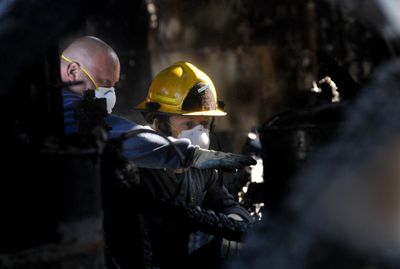Firefighters face greater cancer risk
Many are exposed to toxic chemicals battling blazes

Doug Bacon missed the funeral of a fellow Spokane firefighter because the 59-year-old was in treatment for throat cancer – the same illness that had just killed his friend and co-worker.
A third Spokane firefighter who joined the department with Bacon in the 1970s also has been diagnosed with throat cancer.
“It’s to the point we’re trying to figure out which fire we were all on together,” said Bacon, who survived his cancer and returned to the job in mid-2006. “I’ve got attitude. I fought it.”
Firefighters are at least twice as likely to get cancer as the average person because of exposure to toxins emitted in fires, such as benzene, asbestos and cyanide, studies say. More firefighters have been diagnosed with cancer in the past two years than in the previous 10 years, according to the Firefighter Cancer Support Network and recent studies.
When Bacon was diagnosed with cancer in January 2006, he said he just looked at the doctor and said: “You’re kidding me.” He was unaware at the time that firefighters were more susceptible to the disease. Now, he’s constantly warning young firefighters of the dangers and telling them to keep their masks on – even after the fire’s out.
During July, Spokane area firefighters fought blazes nearly every day, including the massive Valley View wildfire, and two three-alarm fires – The Ugly Duck and Joel building.
Despite wearing protective gear, some walked away from those blazes hacking and coughing. Authorities say asbestos – a cancer-causing agent often found in old building materials – was found in the Joel building.
Research is still being done to determine what level of exposure leads to cancer in firefighters, officials say. Meanwhile, the illness has become a primary concern for the profession.
“Finally we are taking our blinders off when it comes to cancer,” said Michael Dubron, founder and president of the Firefighter Cancer Support Network. Dubron is a cancer survivor and Los Angles firefighter. “With our organization, we are trying to be proactive, such as reducing unnecessary exposure. No longer is it cool to run around with soot-covered uniforms and equipment.”
The soot contains many of the same toxins firefighters are exposed to during a blaze, officials say.
Back in the 1970s, when Bacon started, he said it was macho for firefighters to go into a fire without breathing masks, or they used the paper-based masks that doctors use in operating rooms. What burned back then was mostly wood products, and firefighters were unaware of risks involved in not using proper breathing equipment.
“It never used to be discussed. We never talked about it,” said Spokane Assistant Fire Chief Brian Schaeffer.
Unlike 30 years ago, fire service recruits are told of the risks. Fire officials advocate changes in the industry regarding the illness, such as encouraging health checks early and often in all firefighters and making sure men and women always have clean gear available.
“When you think about firefighters covered in black, you see soot,” said Bobby Halton, editor in chief of Fire Engineering magazine. “I see a lethal mix of toxins.”
Beds where firefighters slept in years past were located next to diesel-powered firetrucks. Crews’ sleeping quarters now are farther away, and elaborate ventilation systems exist, or are being installed, to vent the cancer-causing fumes (officially called polynuclear aromatic hydrocarbons).
Recognizing the growing correlation between cancer and those who work as firefighters, the Washington Legislature amended a law (RCW 51.32.185) in 2007 that considers several types of cancers a hazard of the occupation, which qualifies the professionals for some health benefits.
Also, Schaeffer has asked city officials to buy industrial-size machines to clean personal protective gear.
“I’m willing to do everything I can to help prevent exposure to carcinogens,” Schaeffer said. “With the Washington Fire Chiefs Association, we’re trying to change fire codes to reduce exposure.”
Others in the fire service with broader platforms also try to do their part to spread the word.
Halton, a retired New Mexico fire chief, uses Fire Engineering magazine to raise awareness of firefighter health and wellness.
“If you think about a fire today, they are basically all polymer (plastics) based,” Halton said. “Toxins are always off-gassing. One of the simplest examples is a shower curtain – they are soft at first and nice, then over time they harden – that’s because the gases have left it. If you put that plastic by a fire, it releases the gas at an excelled rate – hydrogen-cyanide.”Halton added: “I bet you I know 100 firefighters right now who are fighting cancer or dying from it. It’s every kind of cancer. … You name it, we got it and it sucks.”
The Los Angeles-based Firefighter Cancer Support Network was founded in 2003. “We have over 1,400 registered members that include 610 cancer survivors that are broken into 46 different types of cancer,” Dubron said. “We have members from all over the world including the United States, United Kingdom, Canada, Australia and Slovenia, who have become very active in the Firefighter Cancer Support Network.”
Dubron said studies being done in the Midwest on the correlation between the fire service and cancer constantly offer new data.
“They are trying to figure out what firefighters have been exposed to,” Dubron said. “We are trying to figure out what causes it, and what cures it.”